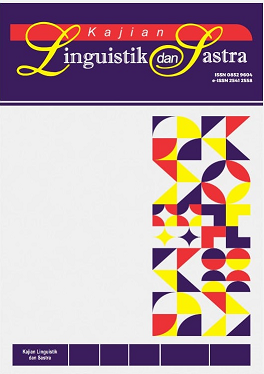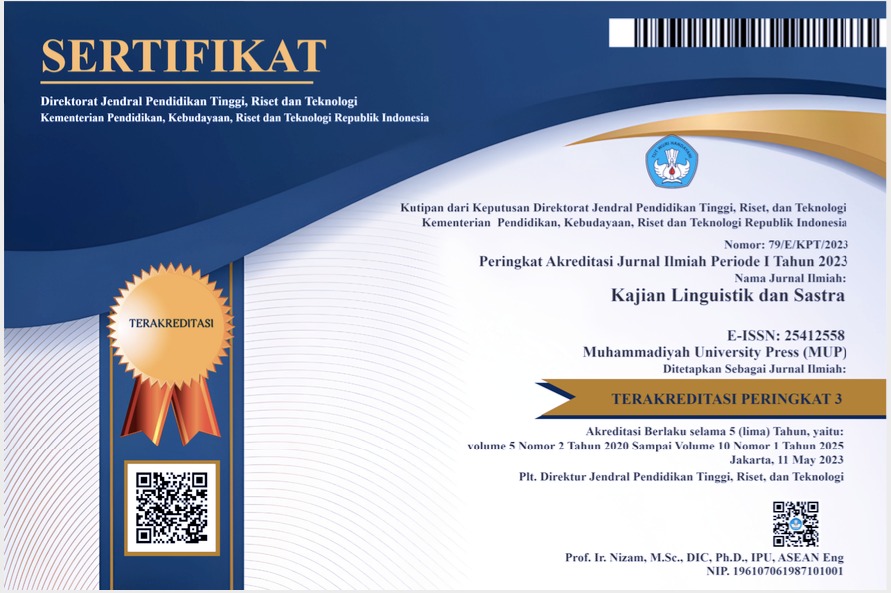Pengaruh Konotasi Negatif Akronim Aplikasi Pemerintah dan Implikasinya terhadap Persepsi Publik: Studi Kasus 11 Aplikasi Pemerintah Indonesia
DOI:
https://doi.org/10.23917/kls.v9i2.6445Abstract
This study aims to investigate the impact of negative connotations in acronyms used by 11 Indonesian government applications. The research focuses on understanding public perception of these acronyms, especially those with vulgar and sexist connotations. The methodology includes a combination of observation and survey methods. Primary data were collected by recording acronyms from official government websites, while secondary data were obtained through a questionnaire survey with 60 respondents (38 females and 22 males). The results show that 52.4% of respondents are aware of these acronyms, and over 90% perceive them as vulgar. Moreover, more than half of the respondents find these acronyms inappropriate for public services, with 52.4% associating them with gender-specific sexual connotations. The study highlights the need for a more culturally sensitive approach in branding public services to avoid alienating the public.
Downloads
References
J. Bynner, “Rethinking the Youth Phase of the Life-course: The Case for Emerging Adulthood?,” J Youth Stud, vol. 8, no. 4, pp. 367–384, Dec. 2005, doi: 10.1080/13676260500431628. DOI: https://doi.org/10.1080/13676260500431628
S. Brazys and N. Hardiman, “From tiger to PIIGS: Ireland and the use of heuristics in comparative political economy,” 2013. DOI: https://doi.org/10.1111/1475-6765.12068
E. R. Puspapertiwi and I. E. Pratiwi, “Beberapa Aplikasi Pemerintah Bernama ‘Nyeleneh’, Ahli IT: Tak Sesuai Etika Profesi,” https://www.kompas.com/tren/read/2024/07/10/210000665/beberapa-aplikasi-pemerintah-bernama-nyeleneh-ahli-it-tak-sesuai-etika?page=all.
M. Altun, “The Power of Language: Exploring its Significance in Shaping Perceptions, Beliefs, and Relationships,” International Journal of Social Sciences & Educational Studies, vol. 10, no. 3, 2023, doi: 10.23918/ijsses.v10i3p362. DOI: https://doi.org/10.23918/ijsses.v10i3p362
R. A. Fitrianingsih, F. Amilia, D. Faricha, R. Kamila, F. Permata, and R. Sari, “AKRONIM BAHASA INDONESIA DI KALANGAN REMAJA.”
M. A. Griffiths, “Brand vulgarity,” Journal of Product & Brand Management, vol. 27, no. 4, pp. 404–414, Jul. 2018, doi: 10.1108/JPBM-01-2017-1385. DOI: https://doi.org/10.1108/JPBM-01-2017-1385
J. Holmes, An Introduction to Sociolinguistics. Routledge, 2013. doi: 10.4324/9781315833057. DOI: https://doi.org/10.4324/9781315833057
Eka. Kurniawan, O. PT Gramedia Pustaka Utama, 2016.
D. Buku and P. Tinggi, RAJAWALI PERS. [Online]. Available: www.rajagrafindo.co.id
E. U. Sutikno, “DENOTATION AND CONNOTATION ON ’PATHETIC FAIRY TALE BY SAPTARASA,” An English-Indonesian journal for English, Education and Culture, vol. 8, no. 1, 2019, doi: 10.31000/globish.v7i2. DOI: https://doi.org/10.31000/globish.v7i2.1129
Dan. Sperber and Deirdre. Wilson, Relevance : communication and cognition. Blackwell Publishers, 20041995.
A. Wicaksono and S. Arimi, “Dominasi Maskulin dalam Akronim Pornografis,” vol. 3, no. 2, pp. 127–136, 2020, [Online]. Available: https://jurnal.ugm.ac.id/v3/db.https://jurnal.ugm.ac.id/v3/db DOI: https://doi.org/10.22146/db.v3i2.4087
P. Pengembangan Linguistik dan Kebijakan Bahasa di Era Kenormalan Baru, E. Bella Andini, and A. Ruhendi Saifullah, Prosiding Seminar Nasional Linguistik dan Sastra (SEMANTIKS) 2021 Makna Konotatif Pada Logo “Nindya Karya” Berbasis Pendekatan Semiotik. [Online]. Available: https://jurnal.uns.ac.id/prosidingsemantiks
Y. C. Sinaga, S. Cyntia, S. Komariah, ) Frinawaty, and L. Barus, “‘CELENGAN RINDU’ KARYA FIERSA BESARI,” Jurnal Metabasa, vol. 3, no. 1, 2021.
S. Negeri and K. Malang, “Pengamatan atas Penggunaan Bahasa Indonesia dalam Media Pers di Era Kekinian Fokus: Konotasi Imam Mutasim”.
S. Salsabila, “806-Article Text-7552-1-10-20220325”.
Badan Pengembangan dan Pembinaan Bahasa, “KBBI VI Daring,” https://kbbi.kemdikbud.go.id/.
N. Luh and P. A. Sulatri, “Ujaran Seksisme Yoshiro Mori: Persoalan Stereotip Gender Pada Olimpiade Tokyo,” Jurnal Studi Kejepangan, vol. 5, 2021. DOI: https://doi.org/10.14710/kiryoku.v5i2.265-271
A. Weatherall, “Language, Gender and Feminism: Theory, Methodology and Practice. Sara Mills and Louise Mullany (2011) London: Routledge, 206pp,” Gender and Language, vol. 8, no. 1, pp. 124–126, Mar. 2014, doi: 10.1558/genl.v8i1.124. DOI: https://doi.org/10.1558/genl.v8i1.124
R. Lakoff, “Language and woman’s place.”
A. Nalivaike, “The Politics of Gender in Ursula Le Guin’s ‘The Dispossessed,’” International Journal of Linguistics, Literature and Culture, vol. 05, no. 01, Mar. 2018, doi: 10.19044/llc.v5no1a2. DOI: https://doi.org/10.19044/llc.v5no1a2
L. Steiner, “Book Review: Cameron, D. (2006). On Language and Sexual Politics. New York: Routledge,” J Lang Soc Psychol, vol. 26, no. 4, pp. 407–410, Dec. 2007, doi: 10.1177/0261927X07306985. DOI: https://doi.org/10.1177/0261927X07306985
L. T. dan S. W. Efendi Anwar, “Resensi_Buku_Bahasa_Masyarakat_Dan_Kekua,” DIKSI, vol. 14, no. 7, pp. 98–101, Jan. 2007. DOI: https://doi.org/10.21831/diksi.v14i1.29647










